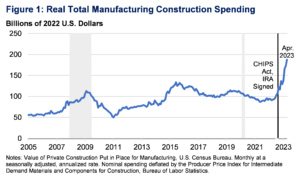MICHIGAN — “BOOOOOOOM!!!!” is a common phrase heard to TikTok users as they stop scrolling when they see the father/son account of AJ and Big Justice. As they peruse the goods at their local Costco, AJ and Big Justice rate the chicken bake, the double chunk chocolate cookie and other Costco items with either a “BOOM” or a “DOOM” giving TikTok users both insights and entertainment.
A different type of boom has been taking place across the United States since Joe Biden and Kamala Harris took office in 2021 in terms of U.S. manufacturing and the frontend construction jobs to build it out. According to the Joint Economic Committee of the United State Senate:
- The Inflation Reduction Act (IRA), Bipartisan Infrastructure Law (BIL), and CHIPS and Science Act (CHIPS Act) are driving investment in domestic manufacturing of things like semiconductors, electric vehicle (EV) batteries, and wind turbines.
- This boost in support has led to a boom in manufacturing construction investment. As of February 2024, there was nearly $223 billion in inflation-adjusted annual U.S. manufacturing construction investment, more than twice the investment in February 2020 or January 2021.
The CHIPS Act and IRA’s targeted investments in science and technology continue to drive manufacturing investment in the electronics and battery industries.
- With the promise of CHIPS Act support, Intel plans to invest over $100 billion in semiconductor manufacturing, research, and development by expanding their facilities and creating new jobs in places like Oregon, Arizona, New Mexico, and Ohio.
- The IRA also included a significant investment in U.S. battery production to support demand for EVs and other clean power applications.
- These investments in computer, electronic, and electrical components have driven nearly the entire increase in manufacturing construction spending, clearly showing how supportive policies backed by Democrats have driven the U.S. manufacturing boom.
The Biden administration ensures that manufacturing investment legislation benefits low-income communities and workers to create good jobs for more Americans.
- Due to legislative incentives aimed at helping low-income communities, economically distressed counties have received a higher share of investments in clean energy, semiconductors, electronics, and other industries.
- The CHIPS Act requires companies applying for funds of $150 million or more to plan for affordable, high-quality child care for their workers and gives preference to companies that provide workforce training and education investments.
- The IRA supports workers by providing increased clean energy tax credits for projects that pay prevailing wages, use registered apprentices and are located in communities that currently or recently relied on fossil fuels to support their local economies.
- Construction employment has grown steadily since President Biden came into office, especially in the nonresidential sector, which covers people who build factories and other commercial structures.
The United State Treasury Department concurs that the United States has seen a surge in manufacturing and construction.
- The boom is principally driven by construction for computer, electronic, and electrical manufacturing—a relatively small share of manufacturing construction over the past few decades, but now a dominant component.
- Manufacturing construction is one element of a broader increase in U.S. non-residential construction spending, alongside new building for public and private infrastructure following the IIJA. The manufacturing surge has not crowded out other types of construction spending, which generally continue to strengthen.
- Finally, we put the trend in international context. While it can be difficult to compare such granular data across countries, the surge appears to be uniquely American—not mirrored in other advanced economies.

Bloomberg News also points out that this BOOM! is causing a boom in supply chain jobs to support both the construction and manufacturing taking place.
“US manufacturing construction spending has surged to a record annualized pace of more than $200 billion, but few companies are shuttering factories elsewhere in the world in order to build in America. Analysts and companies alike have instead taken to tracking megaprojects — defined as construction blueprints valued at more than $1 billion — as a way to measure the manufacturing renaissance. By Melius Research’s count, about $700 billion worth of megaprojects have been announced in North America since the start of 2021; electric-equipment company Eaton Corp., which also tracks the data, pegs the total at $933 billion.”
Also from the article:
“But the story is a bit different for smaller projects. French electrical equipment giant Schneider Electric SE is spending $85 million to add more manufacturing capacity in Tennessee for switchgear and power distribution products. Zurich-based ABB Ltd. officially opened a robotics manufacturing facility and US headquarters building in Michigan that it spent $20 million to expand and retrofit. General Electric Co.’s aerospace arm is investing $450 million this year in new equipment and building upgrades for factories in Alabama, Massachusetts, North Carolina and Ohio, plus another $100 million for specialized tools and custom dies for its forging and casting supply chain and $100 million on plants outside the US. Dutch paint-manufacturer Akzo Nobel NV is investing more than $30 million to expand its powder-coating operations in Indiana, Pennsylvania, Tennessee and Monterrey, Mexico. And those are just the announcements from this week.
This kind of spending isn’t as eye-popping and it’s not enough on its own to fuel the kind of manufacturing super-cycle investors salivated over just a year ago. But these investments are real and happening in fairly short order; they’re related to but not directly dependent on government stimulus packages that have been slow to manifest; and they add up over time to a more robust US industrial economy. The motivations for these factory projects vary, but they’re all focused on making supply chains more reliable and a bet that future demand growth will require more heavily automated manufacturing capacity positioned closer to the end customer.”
Finally, a study finds that much of the investments shepherded by Biden and Harris have gone to counties that have often been overlooked:
